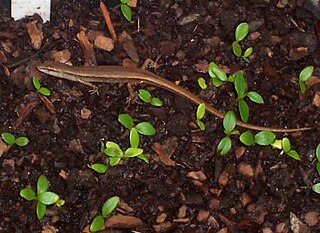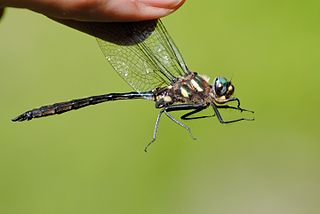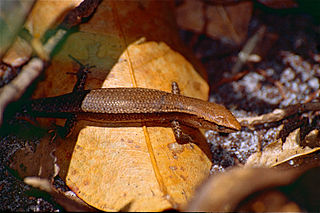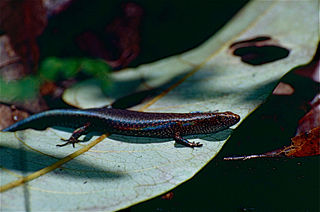
Lampropholis is a genus of skinks, commonly known as sunskinks, in the lizard subfamily Eugongylinae of the family Scincidae. The genus Lampropholis was previously found to belong to a clade with the genera Niveoscincus, Leiolopisma and others of the Eugongylus group within Lygosominae. All species of Lampropholis are endemic to Australia. For similar skinks see genera Bassiana, Pseudemoia, and Niveoscincus.

Lampropholis delicata, the delicate skink, dark-flecked garden sun skink, garden skink, delicate garden skink, rainbow skink or plague skink, or the metallic skink is native to Australia and invasive in New Zealand and Hawaii where it is commonly found in gardens. The species is known for their color dimorphism between males and females; striped morphs and non-striped morphs exist in this species, however the stripe is less pronounced in males. This species' diet consists of a wide range of prey, such as spiders, bees, larvae, and termites. Mating occurs in the late summer and generally one clutch of 2 to 4 eggs are laid per year by each female.

Sepia elongata is a species of cuttlefish native to the northwestern Indian Ocean, specifically from the Red Sea to Somalia. The depth range of S. elongata is unknown.

The elongated shrew is a species of mammal in the family Soricidae. It is endemic to the island of Sulawesi in Indonesia. It lives in the forests of central, northern, and eastern Sulawesi from 200 to 2000 meters elevation.
Grossera elongata is a species of plant in the family Euphorbiaceae. It is endemic to Príncipe.

Scincomorpha is an infraorder and clade of lizards including skinks (Scincidae) and their close relatives. These include the living families Cordylidae, Gerrhosauridae, and Xantusiidae, as well as many extinct taxa. Other roughly equivalent terms include the suborder Scinciformata, or the superfamily Scincoidea, though different authors use these terms in a broader or more restricted usage relative to true skinks. They first appear in the fossil record about 170 million years ago, during the Jurassic period.

Carinascincus metallicus, the metallic cool-skink or metallic skink is a species of skink in the family Scincidae. It is endemic to Australia, found in southern Victoria, as well as in Tasmania where it is the most widespread and common lizard, occurring on many offshore islands in Bass Strait as well as the mainland. It gives birth to live young. It is highly variable in colour and pattern, and may be a complex of closely related species.

Grundy Mountain or Mount Grundy, a mountain of the Great Dividing Range, is located on the Northern Tablelands of New South Wales, Australia.
Leptobotia elongata, the imperial flower loach, elongate loach or royal clown loach, is a species of botiid fish found in flowing water in the upper and middle Yangtze basin in China. It is the largest species in the family, reaching up to 50 cm (1.6 ft) in length and 3 kg (6.6 lb) in weight. Formerly common, the numbers of this vulnerable species have declined because of overfishing, dams, habitat loss and pollution. The species is bred in captivity and a stocking project has been in place since 2010. It is sometimes kept in aquariums, but require a very large tank.

Somatochlora elongata, the ski-tipped emerald or ski-tailed emerald, is a species of dragonfly in the family Corduliidae. It is found in North America.
Lampropholis adonis, also known commonly as the diamond shielded sunskink and Ingram's litter skink, is a species of skink, a lizard in the family Scincidae. The species is endemic to Queensland in Australia.

Lampropholis amicula, the friendly sunskink, is a species of skink, a lizard in the family Scincidae. The species is endemic to Queensland and New South Wales in Australia.
Lampropholis caligula, also known commonly as the montane sunskink or the montane sun skink, is a species of lizard in the family Scincidae. The species is endemic to New South Wales in Australia.

Lampropholis coggeri, also known commonly as the northern sun skink and the rainforest sunskink, is a species of lizard in the family Scincidae. The species is endemic to Queensland in Australia.
Lampropholis colossus, the Bunya sunskink, is a species of skink, a lizard in the family Scincidae. The species is endemic to Queensland in Australia.

Lampropholis couperi, commonly known as the plain-backed sunskink, is a species of skink, a lizard in the family Scincidae. The species is endemic to Queensland, Australia.
Lampropholis mirabilis, the saxicoline sunskink, is a species of skink, a lizard in the family Scincidae. The species is endemic to Queensland in Australia.
Lampropholis robertsi, the grey-bellied sunskink, is a species of skink, a lizard in the family Scincidae. The species is endemic to Queensland in Australia.

Saproscincus czechurai, also known commonly as Czechura's litter-skink, Czechura's skink, and the wedge-snouted shadeskink, is a species of lizard in the family Scincidae. The species is endemic to Queensland in Australia.

The wide-striped mulch slider is a species of skink found in South Australia.













